For anyone who wishes to go backpacking in Vietnam or even move to Vietnam, what to wear in Vietnam is something you’re going to have to think about as you prepare for your trip.
The dress code in Vietnam varies quite a bit depending on where you visit. For example, the north of Vietnam is generally a little more traditional and modest than the south.
There is no law for a dress code in Vietnam per se, and Vietnamese have grown totally accustomed to seeing visiting tourists who dress in ways that they normally wouldn’t in public. Still, dressing a little more conservatively and closer to how the locals dress is a way of showing respect, and you may be treated better as a result.
In this article, we’ll lay out everything you need to know about how to dress in Vietnam, including what the locals wear, what tourists should wear, business and teaching attire, and what NOT to wear in Vietnam.
What Do Vietnamese Wear?
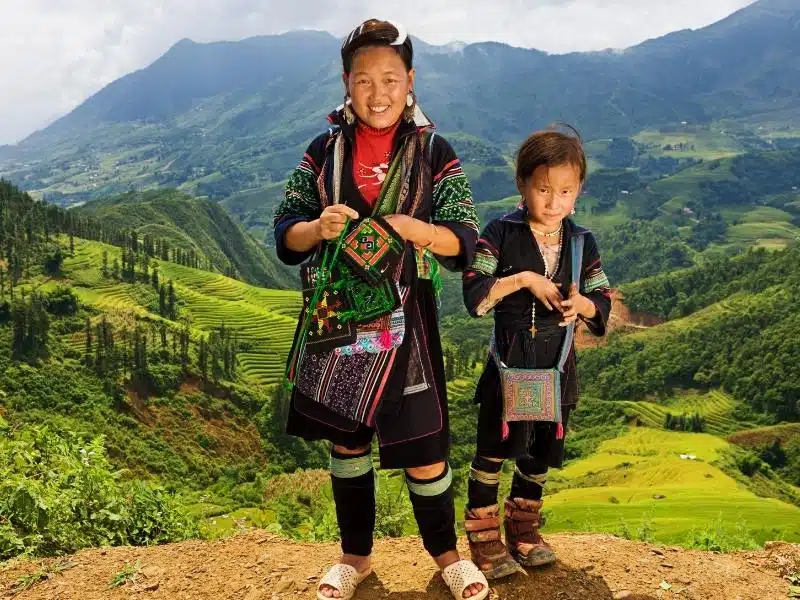
Even the dress code among locals in Vietnam varies quite a bit. For example, in the northwestern highlands around Sapa, many women dress differently according to their tribe (see image above).
Residents of Hanoi in the north, and central cities like Vinh, Hue, Da Nang, and Hoi An generally dress more modestly. For example, the shoulders are usually covered, if not the entire arms, as well as most of the legs. In the far south, by comparison, like Ho Chi Minh City and the Mekong Delta, it is not uncommon for young women to wear short shorts and more revealing tops.
Almost every Vietnamese man wears casual trousers or jeans and a shirt, unless they have a job that requires specific clothing or uniform. Shorts are also fairly common, as are sandals, for both men and women.
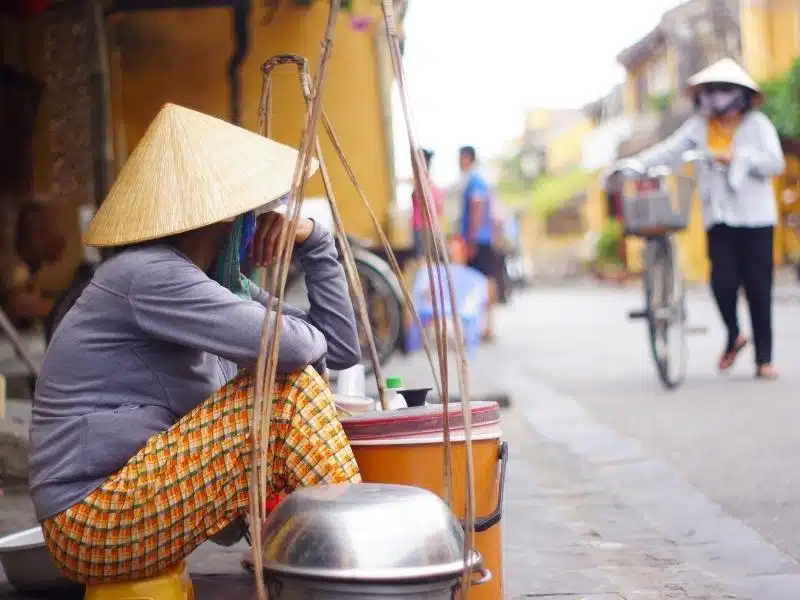
If you’re coming from a country that isn’t so hot, you may be surprised that Vietnamese wear a lot of extra clothing when the weather becomes only slightly cool. For example, you may seem them in hoodies or winter-like jackets when you still think its shorts and T-shirt weather.
As for the traditional conical hats (sometimes called rice hats, rice farmer hats, or rice paddy hats, but in Vietnamese called nón lá), they may be a stereotype of Vietnam, but many locals really do wear them, especially in the countryside.
Traditional Women’s Clothing in Vietnam
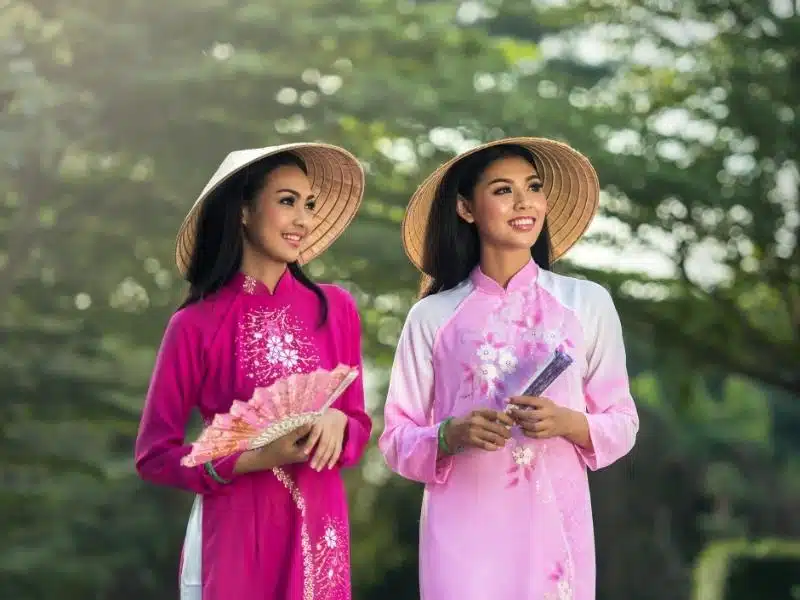
Traditional Vietnamese dresses for women are called Ao Dai (áo dài), which is a long (floor-length) dress with a tiny turtleneck and long sleeves. It has a slit on both sides for women to be able to move comfortably. It is also designed to be tight around the waist.
The dress is usually worn with matching high-waist trousers, which are floor-length as well. Ao Dai are made traditionally of silk and come in different colours and designs. Most of the time, you will see them with beads embedded as a flower design.
Nowadays, Ao Dai may even be worn as a school uniform, wedding dress, birthday dress, graduation dress, or for special occasions. In the businesses that are engaged in tourism, government offices, or banks, Ao Dai can also be seen regularly.
However, in everyday life, most Vietnamese women wear more casual clothing, or perhaps business attire for working.
What about traditional men’s clothing?
Yes, there is actually an Ao Dai for men. However, while it is still fairly common to see women wearing Ao Dai in the situations we described above, it is far less common to see men wearing the male version, which is looser, and often comes with a matching hat.
In the past, these could indicate a man’s position in the social hierarchy. Today, it is possible to see men wearing these at celebrations like weddings in Vietnam or around TET (New Year).
Can I Wear Traditional Vietnamese Clothing for Pictures?
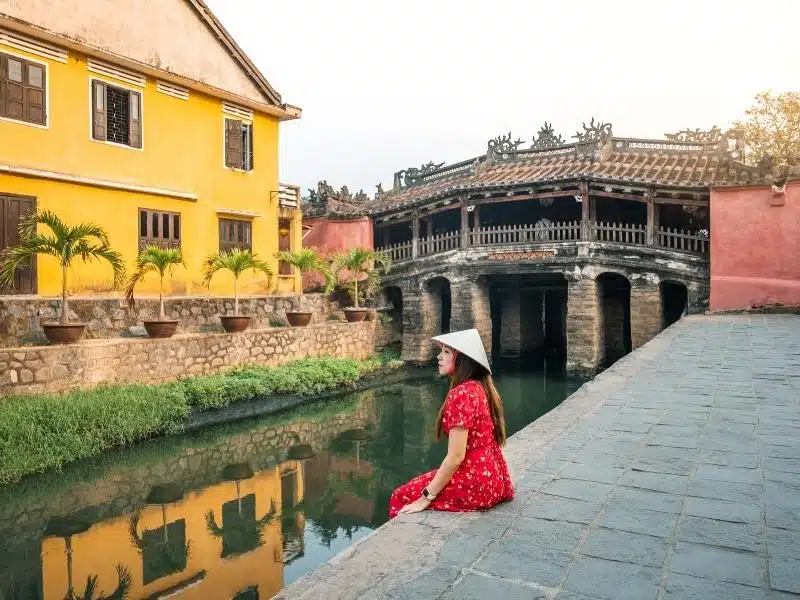
Some travelers like to dress in an Ao Dai for taking pictures in Vietnam, just like many visitors to Japan dress up in a kimono. Will the locals be angry if you do that, or will you be accused of cultural appropriation?
Well, in Vietnam, the answer is no. This is not America. In fact, many may be pleased to see visitors wearing the traditional local attire. However, it is important to wear the clothing respectfully – in other words, wear it in the same way that the locals do, and don’t, for example, modify this traditionally humble clothing to be provocative.
As for the conical rice hats (nón lá), some travelers can be seen sporting them in Vietnam. While you probably would get criticized as a racist for doing this in the US, here in Vietnam, it is unlikely that anyone will care.
North vs South Dress Code

The north of Vietnam, including the capital Hanoi and other cities/areas like Ninh Binh and Halong Bay, as well as Central Vietnam, like Vinh, Hue, Da Nang, and Hoi An, is noticeably more traditional and modest than the far south.
Mainly this is because the north was historically influenced by Chinese culture, and later, communism. In this north, you are more likely to see women covering their full arms and legs. This doesn’t mean you have to. But what it does mean is that you should just pay a little more attention to what you’re wearing and err on the side of modesty.
The south of Vietnam, including Ho Chi Minh City (formerly “Saigon”), the Mekong Delta, Nha Trang, and Mui Ne, is a hint more lack when it comes to dress code. Partially this has to do with less influence from China, and more from Southeast Asian natures, where tropical weather also demands for a less covered dress code.
But also this has to do with modern history – the large American presence in the Vietnam War and the fact that Ho Chi Minh City today is the country’s business center, with lots of foreigners and international companies based there.
Therefore, in the south, you are more likely to see more locals wearing typical Western attire, and less of them covering their arms and legs or wearing traditional Vietnamese clothing.
Beach cities/towns like Nha Trang and Mui Ne are naturally going to be a little more casual, but still, you won’t see Vietnamese people wearing beach attire away from the beach.
What to Wear in Vietnam as a Tourist
Having covered traditional Vietnamese clothing as well as what most Vietnamese wear on normal days, let’s now address the burning question you’re probably asking: what should I wear in Vietnam?
Dress Code for Women in Vietnam

For women, if you want to play it safe and respectful, it is best to cover your shoulders and knees while traveling around in Vietnam. This means long shorts, skirts, or trousers on the bottom and a short or long sleeved shirt on top.
If you’re traveling when it’s hot, aim for thin, light, breathable materials. You know those Thai-pants that every second traveler in Southeast Asia seems to be wearing? Well, they are popular for a reason – they are not only light and comfy but also suitably modest.
If you prefer to wear a tank top, it’s actually fine, but adding a scarf which can easily be pulled over your shoulders whenever you feel necessary can be helpful. And keep in mind that tank tops aren’t really suitable for visiting temples.
Besides shoes, a pair of sandals will be of much use when traveling in Vietnam. These are easier to slip off when necessary in temples, and can just feel nicer to wear when it’s very hot or humid out. This goes for both male and female travelers.
If you’re going out to Vietnamese bars or night clubs, you may unsurprisingly find the dress code more lax. But as with just about anywhere in the world, it’s best to be extra careful and avoid walking alone at night.
Dress Code for Men in Vietnam
For male travelers, pants or shorts plus a T-shirt or long sleeved shirt is the way to go. Think light, loose, breathable materials, especially if you sweat a lot.
Although local men don’t usually wear tank tops, they are totally accustomed to seeing male travelers wearing them. Still, keep in mind that it’s just going to make you stand out even more as a tourist, and you shouldn’t wear them into a temple.
As for going shirtless anywhere besides the beach, that would be a no-no.
Dress Code by Season
What to wear in Vietnam is also going to vary by season. Keep in mind that the weather varies quite a bit across the country, so it’s useful to look up the weather conditions of the specific area you are visiting. Here’s a detailed guide to the weather by month across Vietnam.
If you’re visiting in the rainy season, you’re going to want to bring some clothing that can dry out quickly. The rainy season generally lasts from June to November, with July and August having the highest rainfall. That doesn’t mean it rains all the time.
A poncho or rain coat can also be useful, but keep in mind that even in the rain, Vietnam can be very humid. Therefore, in my experience, when I wear a raincoat or poncho that is too thick, I become a sweaty mess under it, and it tends to stick to my skin.
That’s why I usually prefer an umbrella instead. This can keep you dry enough, without sticking to your body.
Winter, by contrast, tends to be dry. The south of Vietnam still calls for summer-like clothing, but in the north, it can get quite cool. Thermal underwear and a light jacket will be needed. It can get especially cold up in the highlands, so dress appropriately. Learn more about this in our guide to the seasons of Hanoi.
In spring, in the months leading up to the wet season, the temperatures get hotter and hotter, so bring clothes that are light and cover lots of skin.
We cover this topic more in depth in our guide to when to visit Vietnam.
Business Attire in Vietnam

There are no major surprises here. Vietnamese business people wear pretty typical international business attire – that means suits for men, and formal shirt/blouse or suits for women. It is best to avoid flamboyant or brought colors – typical, darker, or neutral colors are best. This is not a business culture where going against the grain is admired.
See here for our guide to getting a business visa in Vietnam.
What to wear for Teaching in Vietnam
For those coming to teach English in Taiwan, the dress code for teachers is going to be modest, but not too formal. For women, pants or shorts/skirts longer than the knees are acceptable. The shoulders should be covered, and the neckline should be high – in other words, lots of cleavage is frowned upon.
For men, whether shorts are allowed or long pants are a must is going to depend on the school’s policies, which can vary quite a bit. Most of the time, really formal attire or a suit is not required. Tank tops are not OK, nor are sandals.
For potential teachers, learn more in our guide to teaching English in Vietnam.
What NOT to Wear or Do in Vietnam

When coming to the country as a tourist, it is important to understand how to properly dress in Vietnam, both to show respect and to stay out of trouble. Here are the things you should remember NOT to do or wear or do while in Vietnam:
- Walk around half-naked anywhere besides the beach. Most places in Vietnam can be very hot and humid in summer, and places in the south like Ho Chi Minh City this is the case year-round. However, this is not an acceptable excuse to remove your t-shirt or wear a bikini top and walk around the city. This shows disrespect to Vietnamese culture and the locals, and you may be treated accordingly.
- Not wearing a bra under a thin or see-through shirt. I do agree that wearing a bra can be very uncomfortable and even painful for most women. However, not wearing a bra when you are wearing a thin/light/white fabric can be offensive to locals and bring unwanted attention to you. If you really hate to use a regular bra, consider other ways, such as wearing a sports bra, using nipple covers, or wear thicker fabric and/or darker colours.
- Wear offensive clothing that insults Vietnam or the Vietnamese government. You should also keep in mind that Vietnam is a communist country which means the government is pretty much in charge and any public comment or insult against it can be punishable by law.
- Not covering up when you should. Make sure to cover your body when you must to show respect. You also can be denied entry if you are not dressed properly. For example, when visiting a temple, pagoda or other prayer building, you must cover up your shoulders, and skirts or shorts should cover the knees.
- Get half or fully naked on the beach. Vietnamese are not used to seeing naked people on the beach. Unless you know for sure that it is a private beach that allows it, do not get half-naked (in other words, women must cover their breast) or fully naked. This is to simply show respect and not make anyone uncomfortable. Vietnam is not Europe.
- Not taking off your shoes when you should. When visiting a religious building, it is usually a must to remove your footwear. The same rule goes when entering a Vietnamese house.
- Too revealing. Unless you don’t mind being stared at, wearing clothing that is too revealing will attract a lot of attention or even unwanted touches in some cases. Sadly, the rights of women to wear what they want in Vietnam is still a struggle, and will probably remain a steep hill to climb in the years or even decades to come.
When to Dress More Modestly
Here are some situations and times when you MUST be covered up, which means, cover up from shoulders down to below your knee (about 3 inches below the knee is recommended):
- When entering one of Vietnam’s temples, churches, mosques, or other religious buildings
- When visiting Ho Chi Minh’s Mausoleum in Hanoi
- When visiting small villages or hill tribes
More Clothing Tips for Vietnam
Here are some additional clothing tips for you while visiting or living in Vietnam:
- Pack some long sleeve blouses – make sure they are light, unless you are going to the north during the winter season. For men, thin long or short-sleeved shirts are fine.
- Bring long but light skirts – this is useful when visiting temples or just for everyday travel.
- Pack a big scarf that can be used as a long skirt when needed, or a smaller scarf for the shoulders to be used whenever you feel that it is more suitable to cover your shoulders, such as busy public places or when entering temples.
- Bring a set of flip-flops – when you are visiting a temple, it is easier to take off and put on your flip-flops than shoes. It also avoids making your socks too dirty, and they dry quickly if they get wet.
- Local clothing tends to be quite small, so if you are bigger, bring what you need when you enter Vietnam.
Following the above dress code for Vietnam shows respect to a culture that is different from yours. It’s like when visiting or staying at someone else’s house, we don’t make ourselves too comfortable to the point that we are offending our host. It is a frustrating fact that women are still struggling to gain equal rights in Vietnam and that we are the ones who need to adjust.
If you find yourself in a situation where you can have an intelligent conversation with a Vietnamese person regarding this topic, try to explain your side without being too arrogant. Remember that it is better to hear other’s side than winning an argument that cannot change anything.
Recommended Vietnam Packing List
If you are looking for the ultimate packing list for Vietnam, either backpacking, travelling with kids or motorbiking, check out our Vietnam packing list for travelers or packing list for anyone moving to Vietnam.
We hope that you found this article about what to wear in Vietnam useful for your upcoming visit to Vietnam. In the end, you can always wear what you want, but dressing appropriately in Vietnam will increase your chances of having a problem-free trip!
Tips for Trip Success
Book Your Flight
Find an inexpensive flight by using Kayak, a favorite of ours because it regularly returns less expensive flight options from a variety of airlines.
Book Your Hotel or Special Accommodation
We are big fans of Booking.com. We like their review system and photos. If we want to see more reviews and additional booking options, we go to Expedia.
You Need Travel Insurance!
Good travel insurance means having total peace of mind. Travel insurance protects you when your medical insurance often will not and better than what you get from your credit card. It will provide comprehensive coverage should you need medical treatment or return to the United States, compensation for trip interruption, baggage loss, and other situations.Find the Perfect Insurance Plan for Your Trip
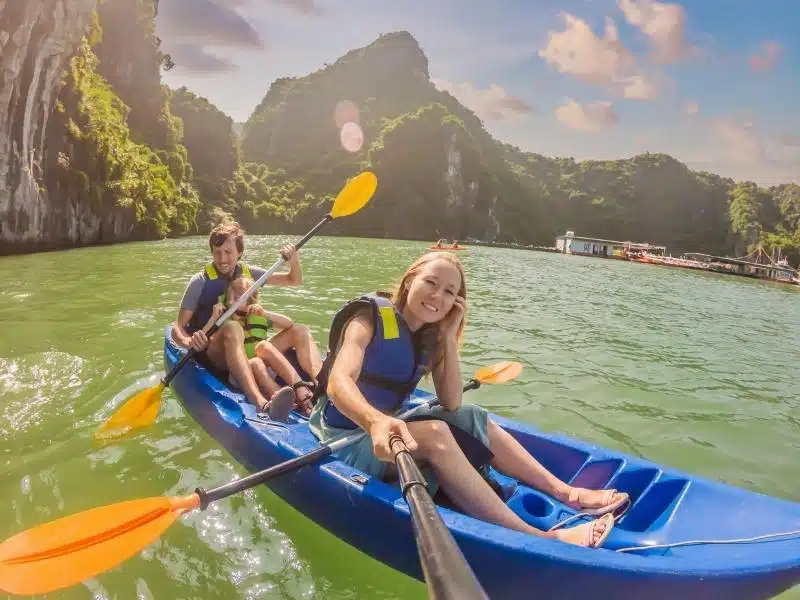
Chris Boyden
Monday 18th of September 2023
Really helpful information, we are planning a trip for next year 🤞 Thank you